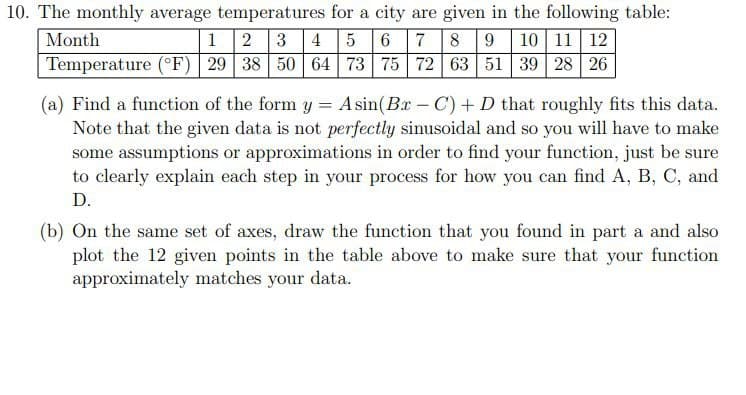10. The monthly average temperatures for a city are given in the following table: Month 1 2 3 4 5 6 7 8 9 10 11 12 Temperature (°F)| 29 38 50 64 73 75 72 63 51 39 28 26 (a) Find a function of the form y = Asin(Bx -C) + D that roughly fits this data. Note that the given data is not perfectly sinusoidal and so you will have to make some assumptions or approximations in order to find your function, just be sure to clearly explain each step in your process for how you can find A, B, C, and D. (b) On the same set of axes, draw the function that you found in part a and also plot the 12 given points in the table above to make sure that your function approximately matches your data.
10. The monthly average temperatures for a city are given in the following table: Month 1 2 3 4 5 6 7 8 9 10 11 12 Temperature (°F)| 29 38 50 64 73 75 72 63 51 39 28 26 (a) Find a function of the form y = Asin(Bx -C) + D that roughly fits this data. Note that the given data is not perfectly sinusoidal and so you will have to make some assumptions or approximations in order to find your function, just be sure to clearly explain each step in your process for how you can find A, B, C, and D. (b) On the same set of axes, draw the function that you found in part a and also plot the 12 given points in the table above to make sure that your function approximately matches your data.
Algebra & Trigonometry with Analytic Geometry
13th Edition
ISBN:9781133382119
Author:Swokowski
Publisher:Swokowski
Chapter7: Analytic Trigonometry
Section7.6: The Inverse Trigonometric Functions
Problem 94E
Related questions
Concept explainers
Contingency Table
A contingency table can be defined as the visual representation of the relationship between two or more categorical variables that can be evaluated and registered. It is a categorical version of the scatterplot, which is used to investigate the linear relationship between two variables. A contingency table is indeed a type of frequency distribution table that displays two variables at the same time.
Binomial Distribution
Binomial is an algebraic expression of the sum or the difference of two terms. Before knowing about binomial distribution, we must know about the binomial theorem.
Topic Video
Question
I need the answer quickly

Transcribed Image Text:10. The monthly average temperatures for a city are given in the following table:
Month
1 2 3 4 5 6 7 8 9 10 11 12
Temperature (°F)| 29 38 50 64 73 75 72 63 51 39 28 26
(a) Find a function of the form y = Asin(Bx -C) + D that roughly fits this data.
Note that the given data is not perfectly sinusoidal and so you will have to make
some assumptions or approximations in order to find your function, just be sure
to clearly explain each step in your process for how you can find A, B, C, and
D.
(b) On the same set of axes, draw the function that you found in part a and also
plot the 12 given points in the table above to make sure that your function
approximately matches your data.
Expert Solution
This question has been solved!
Explore an expertly crafted, step-by-step solution for a thorough understanding of key concepts.
This is a popular solution!
Trending now
This is a popular solution!
Step by step
Solved in 3 steps with 3 images

Knowledge Booster
Learn more about
Need a deep-dive on the concept behind this application? Look no further. Learn more about this topic, trigonometry and related others by exploring similar questions and additional content below.Recommended textbooks for you

Algebra & Trigonometry with Analytic Geometry
Algebra
ISBN:
9781133382119
Author:
Swokowski
Publisher:
Cengage

Algebra & Trigonometry with Analytic Geometry
Algebra
ISBN:
9781133382119
Author:
Swokowski
Publisher:
Cengage